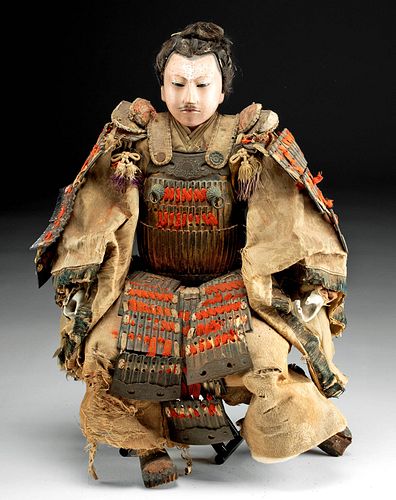Japanese Meiji Gofun, Silk, & Wood Samurai Doll
Lot 66
About Seller
Artemis Fine Arts
686 S Taylor Ave, Ste 106
Louisville, CO 80027
United States
Selling antiquities, ancient and ethnographic art online since 1993, Artemis Gallery specializes in Classical Antiquities (Egyptian, Greek, Roman, Near Eastern), Asian, Pre-Columbian, African / Tribal / Oceanographic art. Our extensive inventory includes pottery, stone, metal, wood, glass and textil...Read more
Categories
Estimate:
$2,400 - $3,600
Absentee vs Live bid
Two ways to bid:
- Leave a max absentee bid and the platform will bid on your behalf up to your maximum bid during the live auction.
- Bid live during the auction and your bids will be submitted real-time to the auctioneer.
Bid Increments
| Price | Bid Increment |
|---|---|
| $0 | $25 |
| $300 | $50 |
| $1,000 | $100 |
| $2,000 | $250 |
| $5,000 | $500 |
| $10,000 | $1,000 |
| $20,000 | $2,500 |
| $50,000 | $5,000 |
| $100,000 | $10,000 |
| $200,000 | $20,000 |
About Auction
By Artemis Fine Arts
Dec 2, 2021
Set Reminder
2021-12-02 10:00:00
2021-12-02 10:00:00
America/New_York
Bidsquare
Bidsquare : Fine Antiquities | Asian | Ethnographic Art
https://www.bidsquare.com/auctions/artemis-gallery/fine-antiquities-asian-ethnographic-art-7918
Features classical antiquities, ancient and ethnographic art from cultures encompassing the globe. Egyptian, Greek, Roman, Etruscan, Near Eastern, Asian, Pre-Columbian, Native American, African / Tribal, Oceanic, Spanish Colonial, Russian, Fine / Visual Arts, so much more! Artemis Fine Arts info@artemisgallery.com
Features classical antiquities, ancient and ethnographic art from cultures encompassing the globe. Egyptian, Greek, Roman, Etruscan, Near Eastern, Asian, Pre-Columbian, Native American, African / Tribal, Oceanic, Spanish Colonial, Russian, Fine / Visual Arts, so much more! Artemis Fine Arts info@artemisgallery.com
- Lot Description
East Asia, Japan, Meiji Period, ca. late 19th to early 20th century CE. A fine gofun and cloth doll representing a samurai or shogun, sitting in a commanding and upright position on a separate black lacquer camp or field chair. He is richly dressed in a silk brocade with metallic threads in the trim around his sleeves. The armor is made of brass segmented panels and breastplate, attached with red and white cords woven through the plates. The body under the clothing is a simple wooden frame with rods as legs and black wood feet. Both hands are gofun, the fingers on both are molded into a curled grip that once held a separate sword or other weapon. The ceramic head is also beautifully rendered with naturalistic glass eyes and horsehair pulled into a topknot. This is a special warrior doll known as a musha-ningyo that was made to celebrate Boy's Day to inspire bravery and courage. The dolls were elaborately dressed and represented ideal heroes and strong leaders from history and legends. Size: 8" L x 15" W x 10" H (20.3 cm x 38.1 cm x 25.4 cm)
The samurai tradition is treasured and unique to Japanese history. The samurai was the venerated guardian of the people, trained from birth to live up to his birthright and work toward the highest honors of his elite class. This class was second only to the Imperial family in the Japanese social hierarchy. Given their place in society, the samurai were great patrons of many artforms, including swords, armor and fittings which were considered works of art. Hence, "Bushido" or "Way of the samurai" is an important aspect of Japanese society. During the Meiji period (1868-1912) and the restoration of the emperor as the locus of power, the musha-ningyo dolls often represented characters that were the most devoted and loyal to the emperor, a subconscious political message to the boys that received these dolls.
Provenance: private Hawaii, USA collection, 1995 to 2010
All items legal to buy/sell under U.S. Statute covering cultural patrimony Code 2600, CHAPTER 14, and are guaranteed to be as described or your money back.
A Certificate of Authenticity will accompany all winning bids.
PLEASE NOTE: Due to recent increases of shipments being seized by Australian & German customs (even for items with pre-UNESCO provenance), we will no longer ship most antiquities and ancient Chinese art to Australia & Germany. For categories of items that are acceptable to ship to Australia or Germany, please contact us directly or work with your local customs brokerage firm.
Display stands not described as included/custom in the item description are for photography purposes only and will not be included with the item upon shipping.
#168414Fair condition. Fading and fraying to fabric. Staining and discoloration to cloth. Losses to cords holding armor plates together and fraying to shoulder pads, hems, posterior, and pants, and some armor segments are loose. Active flaking of fiber particles. Patina on brass areas. Tearing and losses to hair on the dolls head and chips and fading to pigment son face as shown, with modern paint speckles discoloration on the visage. Chips to hands and feet. One leg is reattached with adhesive. Lacquered chair is intact and very good.Condition
- Shipping Info
-
All shipping is handled in-house for your convenience. Your invoice from Artemis Gallery will include shipping calculation instructions. If in doubt, please inquire BEFORE bidding for estimated shipping costs for individual items.
-
- Buyer's Premium



 EUR
EUR CAD
CAD AUD
AUD GBP
GBP MXN
MXN HKD
HKD CNY
CNY MYR
MYR SEK
SEK SGD
SGD CHF
CHF THB
THB














